belt OLDSMOBILE SILHOUETTE 1998 Owner's Manual
[x] Cancel search | Manufacturer: OLDSMOBILE, Model Year: 1998, Model line: SILHOUETTE, Model: OLDSMOBILE SILHOUETTE 1998Pages: 444, PDF Size: 23.2 MB
Page 51 of 444
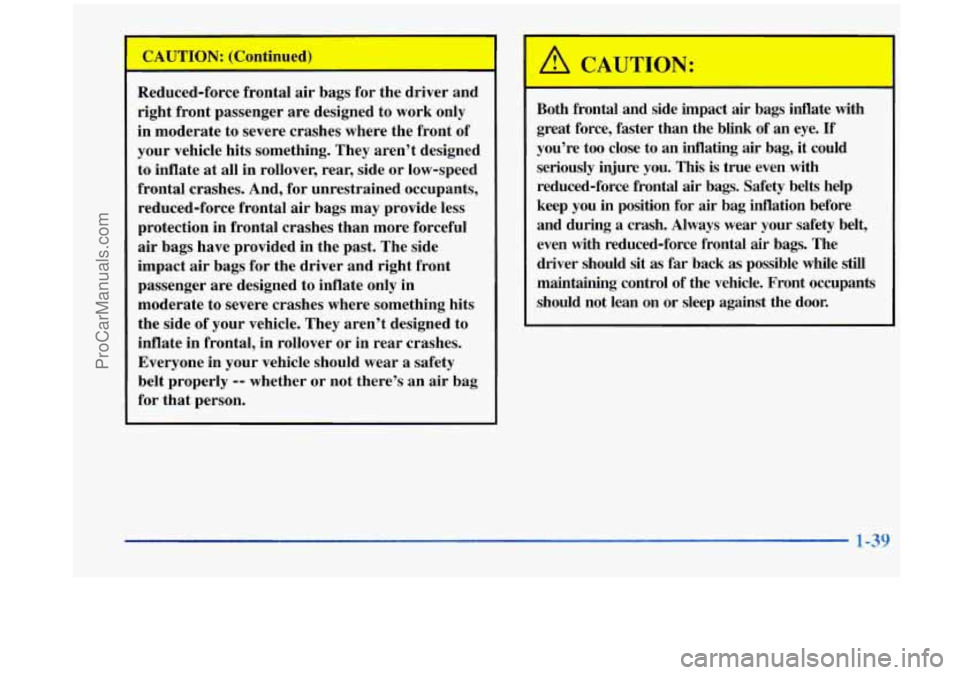
CAUTION: (Continued) .
Reduced-force frontal air bags for the driver and
right front passenger are designed to work only
in moderate to severe crashes where the front of
your vehicle hits something. They aren’t designed
to inflate
at all in rollover, rear, side or low-speed
frontal crashes. And, for unrestrained occupants,
reduced-force frontal air bags may provide less
protection in frontal crashes than more forceful air bags have provided in the past. The side
impact
air bags for the driver and right front
passenger are designed to inflate only in
moderate to severe crashes where something hits
the side of your vehicle. They aren’t designed
to
inflate in frontal, in rollover or in rear crashes.
Everyone in your vehicle should wear a safety belt properly
-- whether or not there’s an air bag
for that person.
A CAUTION:
Both frontal and side impact air bags inflate with
great force, faster than the blink of an eye.
If
you’re too close to an inflating air bag, it could
seriously injure you. This
is true even with
reduced-force frontal air bags. Safety belts help
keep you in position for air bag inflation before
and during
a crash. Always wear your safety belt,
’ even with reduced-force frontal air bags. The
~ driver should sit as far back as possible while still
l
maintaining control of the vehicle. Front occupants
should not lean on or sleep against the door.
1-39
ProCarManuals.com
Page 52 of 444
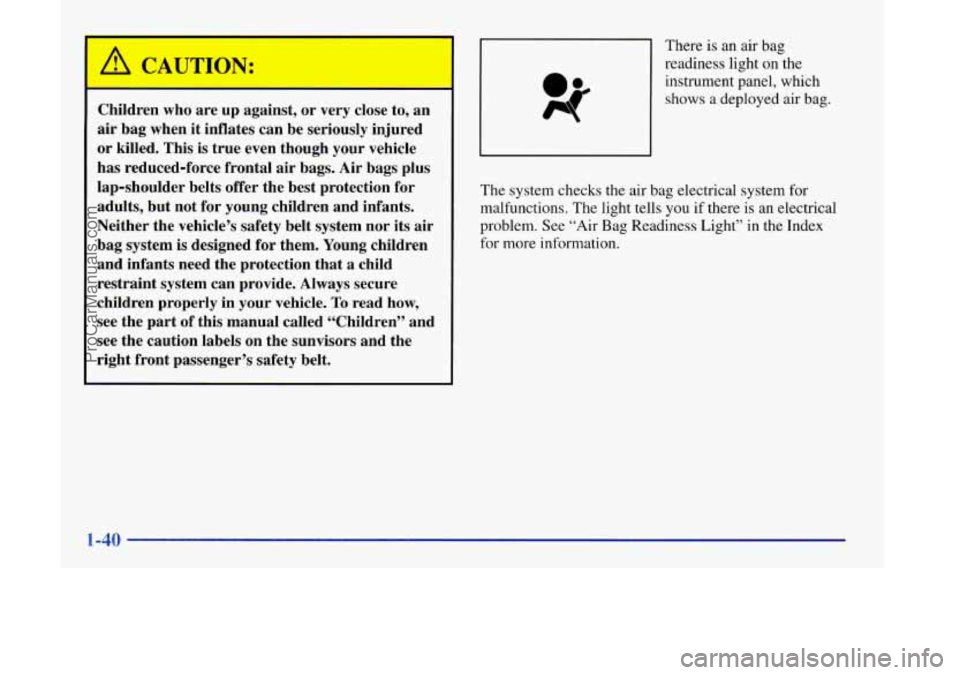
I
Children who are up against, or very close to, an
air bag when it inflates can be seriously injured
or killed. This is true even though your vehicle
has reduced-force frontal air bags. Air bags plus
lap-shoulder belts offer the best protection for adults, but not for young children and infants.
Neither the vehicle’s safety belt system nor its
air
bag system is designed for them. Young children
and infants need the protection that
a child
restraint system can provide.
Always secure
children properly in your vehicle.
To read how,
see the part of this manual called “Children” and
see the caution labels on the sunvisors and the
right front passenger’s safety belt. There
is an air bag
readiness light on the
instrument panel, which
shows a deployed air bag.
The system checks the air bag electrical system for
malfunctions. The light tells you if there is an electrical
problem. See “Air Bag Readiness Light” in the Index
for more information.
1-40
ProCarManuals.com
Page 56 of 444
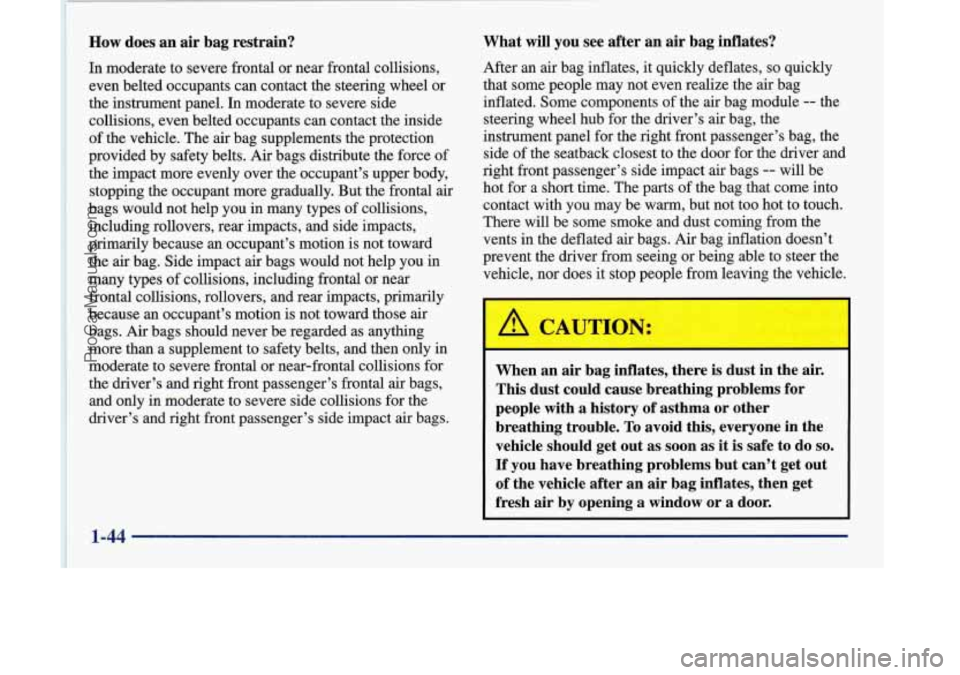
How does an air bag restrain?
In moderate to severe frontal or near frontal collisions,
even belted occupants can contact the steering wheel or
the instrument panel. In moderate
to severe side
collisions, even belted occupants can contact the inside
of the vehicle. The
air bag supplements the protection
provided by safety belts. Air bags distribute the force of
the impact more evenly over the occupant’s upper body,
stopping the occupant more gradually. But the frontal
air
bags would not help you in many types of collisions,
including rollovers, rear impacts, and side impacts,
primarily because an occupant’s motion is not toward
the air bag. Side impact air bags would not help you in
many types of collisions, including frontal or near
’ frontal collisions, rollovers, and rear impacts, primarily
because an occupant’s motion is not toward those air
bags.
Air bags should never be regarded as anything
more than a supplement to safety belts, and then only in
moderate to severe frontal or near-frontal collisions for
the driver’s and right front passenger’s frontal air bags,
and only in moderate to severe side collisions for the
driver’s and right front passenger’s side impact air bags.
What will you see after an air bag inflates?
After an air bag inflates, it quickly deflates, so quickly
that some people may not even realize the air bag
inflated. Some components of the air bag module
-- the
steering wheel hub for the driver’s
air bag, the
instrument panel for the right front passenger’s bag, the
side of the seatback closest to the door for the driver and
right front passenger’s side impact air bags
-- will be
hot for a short time. The parts of the bag that come into
contact with you may be warm, but not too hot to touch.
There will be some smoke and dust coming from the
vents in the deflated air bags. Air bag inflation doesn’t
prevent the driver from seeing or being able to steer the
vehicle, nor does it stop people from leaving the vehicle.
When an air bag inflates, there is dust in the air.
This dust could cause breathing problems for
people with
a history of asthma or other
breathing trouble. To avoid this, everyone in the
vehicle should get out
as soon as it is safe to do so.
If you have breathing problems but can’t get out
of the vehicle after an air bag inflates, then get
fresh air by opening a window or a door.
1-44
ProCarManuals.com
Page 57 of 444

In many crashes severe enough to inflate an air bag,
windshields are broken by vehicle deformation.
Additional windshield breakage may also occur from the
right front passenger air bag.
Air bags are designed to inflate only once. After an
air bag inflates, you’ll need some new parts for your
air bag system.
If you don’t get them, the air bag
system won’t be there to help protect you in another
crash. A new system will include air bag modules
and possibly other parts. The service manual for your
vehicle covers the need to replace other parts.
Your vehicle is equipped with a crash sensing and
diagnostic module, which records information about
the frontal air bag system. The module records
information about the readiness of the system, when
the sensors are activated and driver’s safety belt
usage at deployment.
Let only qualified technicians work on your air bag
systems. Improper service can mean that an air bag
system won’t work properly. See your retailer
for service.
I NOTICE:
If you damage the covering for the driver’s or the
right front passenger’s air bag, or the air bag
covering on the driver’s and right front
passenger’s seatback, the bag may not work
properly.
You may have to replace the air bag
module in the steering wheel, both the air bag
module and the instrument panel for the right
front passenger’s air bag, or both the air bag
module and seatback for the driver’s and right
front passenger’s side impact air bag.
Do not
open or break the air bag coverings.
ProCarManuals.com
Page 58 of 444

If your vehicle ever gets into a lot of water -- such as
water up to the carpeting or higher
-- or if water enters
your vehicle and soaks the carpet, the air bag controller
can be soaked and ruined.
If this ever happens, and then
you start your vehicle, the damage could make the
frontal and side impact air bags inflate and safety belt
pretensioners activate, even if there’s no crash. You
would have to replace the air bags, all the sensors and
related parts, parts of the safety belt system and parts
of
the driver and right front passenger’s seatbacks. If your
vehicle is ever in a
flood, or if it’s exposed to water that
soaks the carpet, you can avoid needless repair costs by
turning off the vehicle immediately. Don’t let anyone
start the vehicle, even to tow it, unless the battery cables
are first disconnected.
Servicing Your Air Bag-Equipped Vehicle
Air bags affect how your vehicle should be serviced.
There are parts of the air bag systems in several places
around your vehicle. Your retailer and the Silhouette
Service Manual have information about servicing your
vehicle and the
air bag systems. To purchase a service
manual, see “Service and Owner Publications” in
the Index.
For up to 10 minutes after the ignition key is
, turned off and the battery is disconnected, an air
bag can still inflate during improper service. You
can be injured if you are close to an air bag when
it inflates. Avoid wires wrapped with yellow tape
or yellow connectors. They are probably part of
the air bag systems. Be sure
to follow proper
service procedures, and make sure the person
performing work for you is qualified to do
so.
~~ ~~
The air bag systems do not need regular maintenance.
1-46
ProCarManuals.com
Page 59 of 444
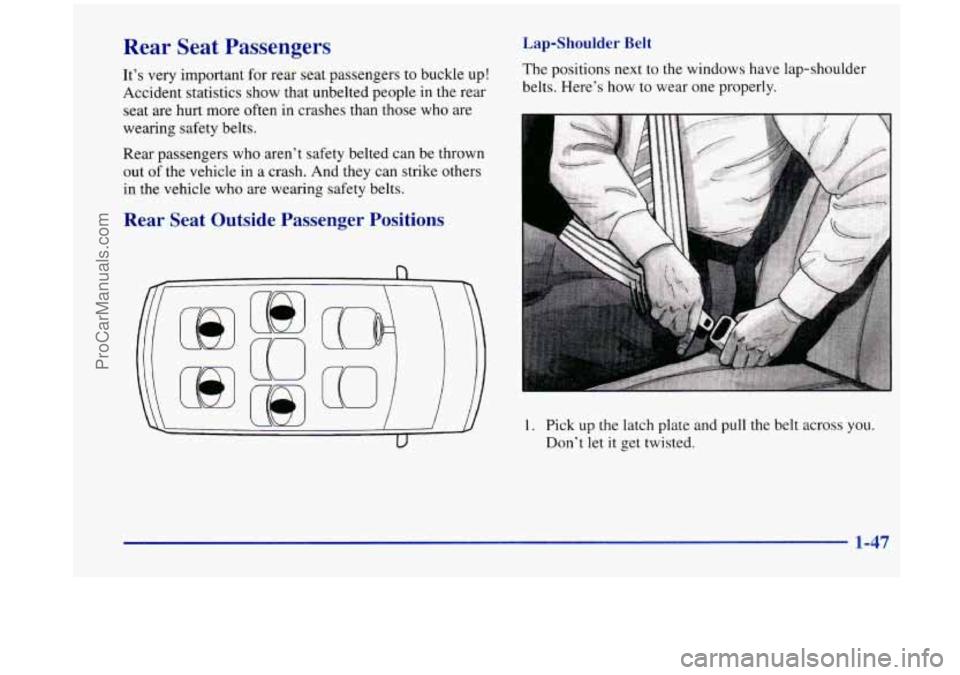
Rear Seat Passengers
It’s very important for rear seat passengers to buckle up!
Accident statistics show that unbelted people in the rear
seat are hurt more often in crashes than those who are
wearing safety belts.
Rear passengers who aren’t safety belted can be thrown
out
of the vehicle in a crash. And they can strike others
in the vehicle who are wearing safety belts.
Lap-Shoulder Belt
The positions next to the windows have lap-shoulder
belts. Here’s how
to wear one properly.
Rear Seat Outside Passenger Positions
1. Pick up the latch plate and pull the belt across you.
Don’t let it get twisted.
1-47
ProCarManuals.com
Page 60 of 444
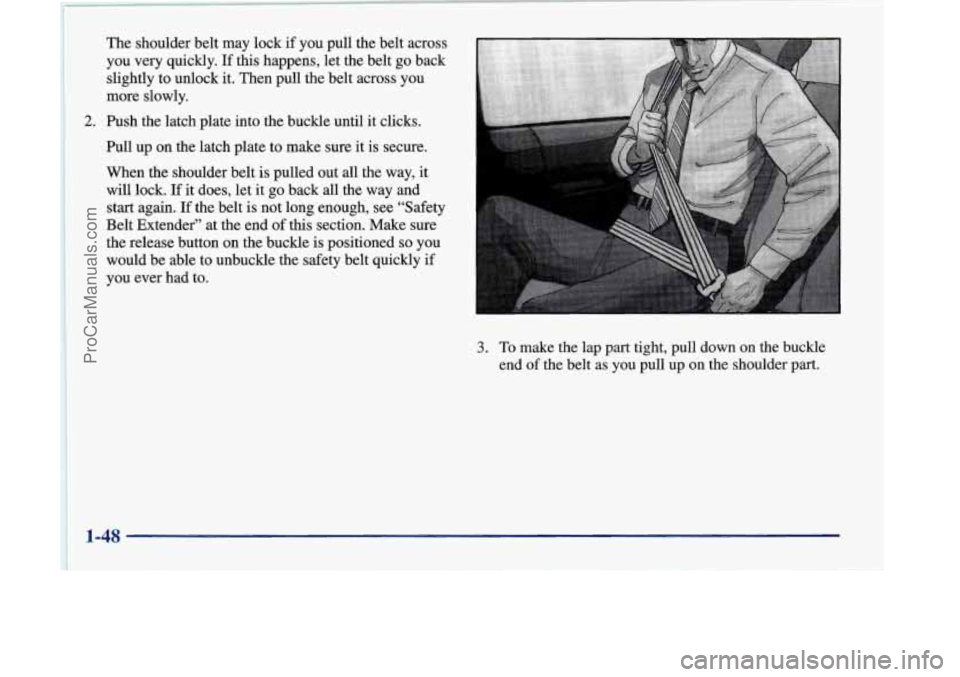
The shoulder belt may lock if you pull the belt across
you very quickly. If
this happens, let the belt go back
slightly to unlock it. Then pull the belt across you
more slowly.
2. Push the latch plate into the buckle until it clicks.
Pull up on the latch plate to make sure it
is secure.
When the shoulder belt is pulled out
all the way, it
will lock.
If it does, let it go back all the way and
start again.
If the belt is not long enough, see “Safety
Belt Extender” at the end
of this section. Make sure
the release button on the buckle is positioned
so you
would be able to unbuckle the safety belt quickly if
you ever had to.
3. To make the lap part tight, pull down on the buckle
end of the belt as you pull up on the shoulder part.
1-48
ProCarManuals.com
Page 61 of 444
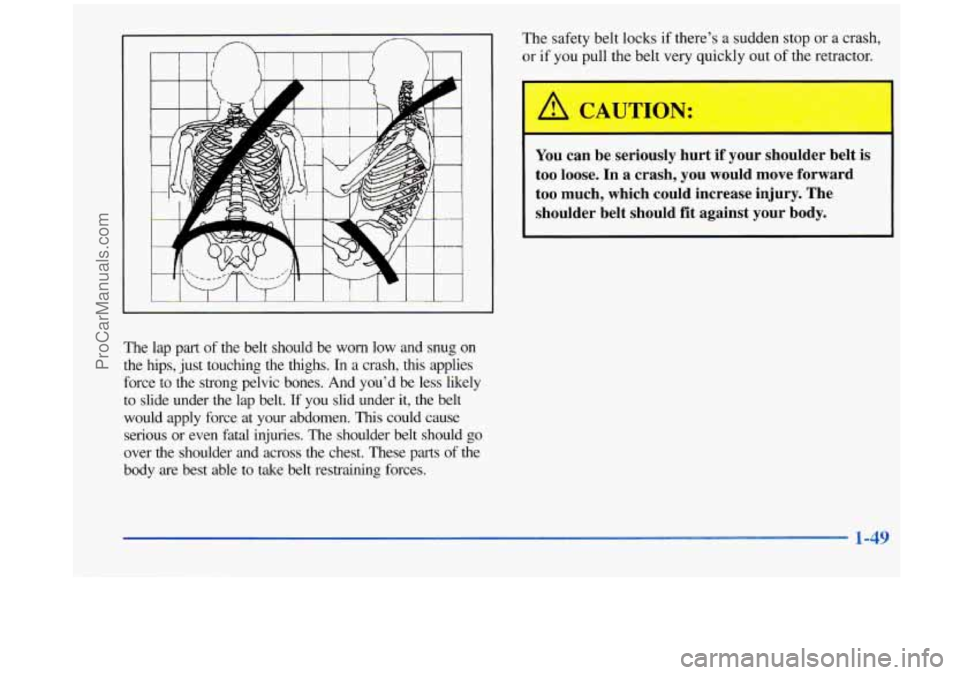
n /- I
I
The lap part of the belt should be worn low and snug on
the hips, just touching the thighs. In a crash, this applies
force to the strong pelvic bones. And you’d be less likely
to slide under the lap belt. If
you slid under it, the belt
would apply force at your abdomen.
This could cause
serious or even fatal injuries. The shoulder belt
should go
over the shoulder and across the chest. These parts of the
body are best able to take belt restraining forces. The safety belt locks
if there’s
a sudden stop or a cram,
or
if you pull the belt very quickly out of the retractor.
I
You can be seriously hurt if your shoulder belt is
too loose. In a crash, you would move forward
too much, which could increase injury. The
shoulder belt should fit against your body.
1-49
ProCarManuals.com
Page 62 of 444
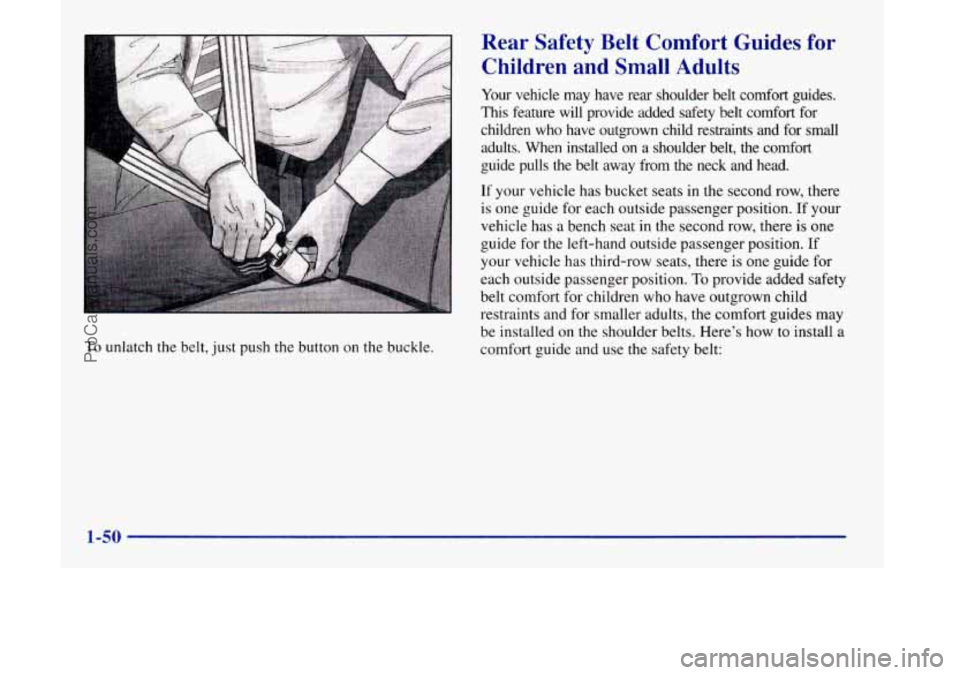
To unlatch the belt, just push the button on the buckle.
Rear Safety Belt Comfort Guides for
Children and Small Adults
Your vehicle may have rear shoulder belt comfort guides.
This feature will provide added safety belt comfort for
children who have outgrown child restraints and for small adults. When installed on
a shoulder belt, the comfort
guide pulls the belt away from the neck and head.
If your vehicle has bucket seats in the second row, there
is one guide for each outside passenger position. If your
vehicle has a bench seat in the second row, there is one
guide for the left-hand outside passenger position. If
your vehicle has third-row seats, there is one guide for
each outside passenger position.
To provide added safety
belt comfort for children who have outgrown child
restraints and for smaller adults, the comfort guides may
be installed on the shoulder belts. Here’s how to install a
comfort guide and use
the safety belt:
1-50
ProCarManuals.com
Page 63 of 444
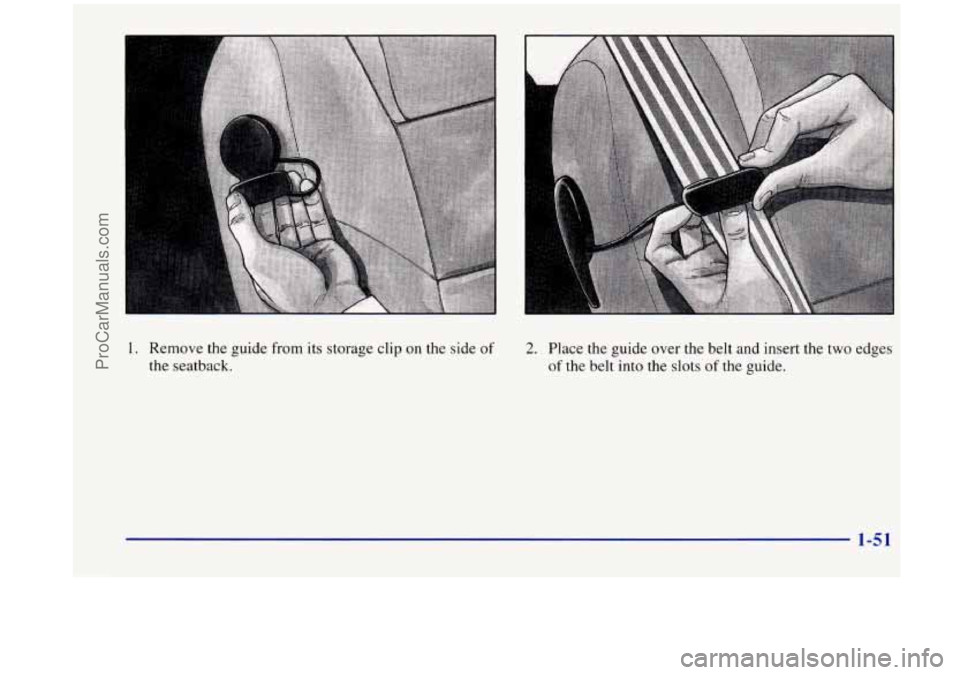
1. Remove the guide from its storage clip on the side of
the seatback.
2. Place the guide over the belt and insert the two edges
of the belt into the slots of the guide.
1-51
ProCarManuals.com